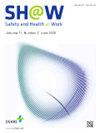Occupational Heat Exposure-related Symptoms Prevalence and Associated Factors Among Hospitality Industry Kitchen Workers in Ethiopia: Wet Bulb Globe Temperature
IF 2.9
3区 医学
Q1 PUBLIC, ENVIRONMENTAL & OCCUPATIONAL HEALTH
引用次数: 0
Abstract
Background
Occupational heat stress caused by excessive environmental heat gain disrupts thermoregulatory mechanisms and harm workers' health and productivity. Kitchens are known for their thermal risks; however, research on heat stress in kitchen is limited. This study aimed to bridge this knowledge gap by assessing, the prevalence of heat-stress-related symptoms, and associated factors among kitchen workers in Gondar City, Ethiopia.
Methods
This institutional-based cross-sectional study (April to June 2023) evaluated heat stress among hospitality kitchen workers in Ethiopia. Heat exposure was measured using hygrometers. A simple random sample of 605 participants completed a survey and data was exported to Statistical Package for Social Science version 26. To assess strength and direction an adjusted odds ratio with 95% confidence interval (CI) was employed. A p-value of less than 0.05 was utilized to identify significant associations.
Results
Over the last 6 months 67.1% (95% CI: 63.0, 71.1), of the participants reported heat-stress symptoms. Multivariable analysis revealed that age ≥40 years [AOR: 2.28; 95% CI (1.08, 4.82)], high workload [AOR: 1.89; 95% CI (1.04, 3.49)], poor heat mitigation practice [AOR: 2.39; 95% CI (1.58, 3.59), wood fuel [AOR: 2.60; 95% CI (1.54, 4.40)], improper ventilation [AOR: 3.28; 95% CI (1.56, 6.87)], and higher heat index value [AOR: 2.15; 95% CI (1.35, 3.42)] were factors significatly associated with heat stress related symptoms.
Conclusion
This study identified a high prevalence of heat–stress-related symptoms among kitchen workers. Mitigation strategies include improved ventilation, cooling, advanced building designs, and heat reduction technologies. Future research should utilize standard heat-stress assessment tools.
埃塞俄比亚餐饮业厨房工人职业热暴露相关症状流行率及相关因素:湿球温度
背景:过度的环境热增益引起的职业热应激破坏了体温调节机制,损害了工人的健康和生产力。众所周知,厨房存在热风险;然而,对厨房热应力的研究是有限的。本研究旨在通过评估埃塞俄比亚贡达尔市厨房工人中热应激相关症状的流行程度和相关因素,弥合这一知识差距。方法这项基于机构的横断面研究(2023年4月至6月)评估了埃塞俄比亚酒店厨房工人的热应激。热暴露用湿度计测量。简单随机抽样605名参与者完成调查,数据导出到社会科学统计软件包第26版。为了评估强度和方向,采用95%可信区间(CI)的调整优势比。采用小于0.05的p值来确定显著相关性。结果在过去的6个月里,67.1% (95% CI: 63.0, 71.1)的参与者报告了热应激症状。多变量分析显示年龄≥40岁[AOR: 2.28;95% CI(1.08, 4.82)],高工作量[AOR: 1.89;95% CI(1.04, 3.49)],不良的减热措施[AOR: 2.39;95% CI(1.58, 3.59),木材燃料[AOR: 2.60;95% CI(1.54, 4.40)],通气不当[AOR: 3.28;95% CI(1.56, 6.87)]和较高的热指数值[AOR: 2.15;95% CI(1.35, 3.42)]是与热应激相关症状显著相关的因素。结论本研究确定了厨房工人中热应激相关症状的高发率。缓解策略包括改善通风、冷却、先进的建筑设计和减少热量的技术。未来的研究应利用标准的热应力评估工具。
本文章由计算机程序翻译,如有差异,请以英文原文为准。
求助全文
约1分钟内获得全文
求助全文
来源期刊

Safety and Health at Work
Social Sciences-Safety Research
CiteScore
6.40
自引率
5.70%
发文量
1080
审稿时长
38 days
期刊介绍:
Safety and Health at Work (SH@W) is an international, peer-reviewed, interdisciplinary journal published quarterly in English beginning in 2010. The journal is aimed at providing grounds for the exchange of ideas and data developed through research experience in the broad field of occupational health and safety. Articles may deal with scientific research to improve workers'' health and safety by eliminating occupational accidents and diseases, pursuing a better working life, and creating a safe and comfortable working environment. The journal focuses primarily on original articles across the whole scope of occupational health and safety, but also welcomes up-to-date review papers and short communications and commentaries on urgent issues and case studies on unique epidemiological survey, methods of accident investigation, and analysis. High priority will be given to articles on occupational epidemiology, medicine, hygiene, toxicology, nursing and health services, work safety, ergonomics, work organization, engineering of safety (mechanical, electrical, chemical, and construction), safety management and policy, and studies related to economic evaluation and its social policy and organizational aspects. Its abbreviated title is Saf Health Work.
 求助内容:
求助内容: 应助结果提醒方式:
应助结果提醒方式:


